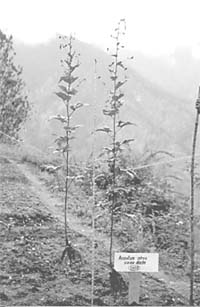The Himalayan herb grower
 a man with a mission, Arun Kumar Badoni's life work is to put cultivation of rare and endangered Himalayan medicinal and aromatic plants on the development agenda of mountain districts in the Uttarkhand region of Uttar Pradesh. He has been able to grow various endangered high-altitude herbs without any financial and infrastructural luxuries enjoyed by scientists in government research institutes or major pharmaceutical companies.
a man with a mission, Arun Kumar Badoni's life work is to put cultivation of rare and endangered Himalayan medicinal and aromatic plants on the development agenda of mountain districts in the Uttarkhand region of Uttar Pradesh. He has been able to grow various endangered high-altitude herbs without any financial and infrastructural luxuries enjoyed by scientists in government research institutes or major pharmaceutical companies.
Perhaps, no individual or institution has produced the variety and quantity of plants he has been able to. He has also been able to speed up the lifecycle of these plants. This has helped in getting farmers interested in the cultivation of medicinal plants for commercial purposes. His greatest success has been with Aconitum heterophyllum , locally known as ateesh , an endangered plant in great demand in the Indian ayurvedic industry and herbal pharmaceutical industry abroad.
Badoni's lifetime fascination with medicinal plants traces its origin to the memories of his grandfather, who was a renowned vaid (a traditional healer). His pioneering work in the field of biodiversity conservation began with the setting up of an informal organisation in 1989, aptly named sher (Society for Himalayan Environmental Research), by a group of college students with similar concerns and interests. At that time, he was pursuing a DPhil, first in tree biology and then taxonomy, at the Garhwal University. He did his thesis on the "Herbaceous Flora of District Uttarkashi'.
While engaged in this research, he became increasingly concerned about the over-exploitation of many medicinal plants beyond their capacity to regenerate naturally. He identified such plants and concluded that over-harvesting for commercial purposes by major pharmaceutical companies contributed to their decline.
Badoni wrote letters to officials concerned, informing them about the deteriorating environmental conditions in the remote regions of Garhwal, and suggested measures that could be adopted to undo the damage. He emphasised on in situ (in its natural habitat) conservation of endangered and threatened species of medicinal and aromatic plants. Badoni reasoned that these plants were indicators of the overall health of the ecosystem and that, if they were disappearing, the entire ecosystem would be threatened. He also saw potential for tremendous economic benefits to local village communities, who had so far been unable to benefit from their herbal wealth. By cultivating medicinal plants for commercial purposes, they could supplement their income.
But the responses to his letters were varied. So Badoni decided to take the matter in his own hands. He pursued his dream of growing endangered species from seeds painstakingly collected from the wild. After his initial experiments had
